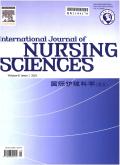Effects of the hospital-community-family trinity cardiac rehabilitation on patients with acute myocardial infarction after percutaneous coronary intervention: A randomized trial
IF 3.1
3区 医学
Q1 NURSING
引用次数: 0
Abstract
Objectives
This study aimed to develop a hospital-community-family trinity cardiac rehabilitation (CR) intervention program and assess its’ effects on patients with acute myocardial infarction (AMI) after percutaneous coronary intervention (PCI).
Methods
Between April 2022 and April 2023, patients who had experienced AMI after PCI were enrolled. These patients were randomly assigned to an intervention group (IG) or a control group (CG) in equal numbers. The CG received standard CR, while the IG participated in the advanced trinity CR program in addition to the standard CR. Key parameters measured included the anaerobic threshold (AT), maximum oxygen uptake (V̇O2max), maximum exercise load (MEL), metabolic equivalent (MET), left ventricular ejection fraction (LVEF), left ventricular end-systolic volume (LVESV), left ventricular end-diastolic volume (LVEDV), and quality of life (measured by the SF-36). These were assessed pre-intervention and at 3, 6, 9, and 12 months post-intervention. SPSS.26 was employed for data analysis, with statistical methods such as repeated measures analysis of variance (ANOVA), Chi-square tests, and independent sample t-tests.
Results
A total of 110 patients completed the intervention, 55 in each group. There was no significant difference in the scores of all indicators between the two groups before intervention (P > 0.05). However, at 3, 6, 9 and 12 months after intervention, the scores of AT, VO2max, MEL, MET, LVEDV, LVESV, LVEF, and quality of life in the intervention group were higher than those in the control group, there was statistical significance at four-time points, group, time, and interaction effect (P < 0.05).
Conclusions
The hospital-community-family trinity CR intervention program developted in this study significantly improved exercise endurance, cardiac function, and quality of life in patients with AMI after PCI.
医院-社区-家庭三位一体心脏康复对急性心肌梗死患者经皮冠状动脉介入治疗后的疗效:一项随机试验
目的建立医院-社区-家庭三位一体的心脏康复(CR)干预方案,评估其对急性心肌梗死(AMI)患者经皮冠状动脉介入治疗(PCI)的效果。方法纳入2022年4月至2023年4月期间PCI术后发生AMI的患者。这些患者被随机分为干预组(IG)和对照组(CG)。CG组接受标准CR, IG组在标准CR的基础上进行高级三位制CR,主要参数包括无氧阈值(AT)、最大摄氧量(V * O2max)、最大运动负荷(MEL)、代谢当量(MET)、左室射血分数(LVEF)、左室收缩末容积(LVESV)、左室舒张末容积(LVEDV)和生活质量(SF-36测量)。分别在干预前、干预后3、6、9和12个月进行评估。采用SPSS.26进行数据分析,采用重复测量方差分析(ANOVA)、卡方检验、独立样本t检验等统计方法。结果共110例患者完成干预,每组55例。干预前两组患者各项指标得分比较,差异均无统计学意义(P >;0.05)。但在干预后3、6、9、12个月,干预组at、VO2max、MEL、MET、LVEDV、LVESV、LVEF评分及生活质量评分均高于对照组,且在4个时间点、组、时间、交互效应上差异均有统计学意义(P <;0.05)。结论本研究提出的医院-社区-家庭三位一体的CR干预方案可显著改善PCI术后AMI患者的运动耐力、心功能和生活质量。
本文章由计算机程序翻译,如有差异,请以英文原文为准。
求助全文
约1分钟内获得全文
求助全文
来源期刊

International Journal of Nursing Sciences
Nursing-Nursing (all)
CiteScore
6.10
自引率
2.60%
发文量
408
审稿时长
25 days
期刊介绍:
This journal aims to promote excellence in nursing and health care through the dissemination of the latest, evidence-based, peer-reviewed clinical information and original research, providing an international platform for exchanging knowledge, research findings and nursing practice experience. This journal covers a wide range of nursing topics such as advanced nursing practice, bio-psychosocial issues related to health, cultural perspectives, lifestyle change as a component of health promotion, chronic disease, including end-of-life care, family care giving. IJNSS publishes four issues per year in Jan/Apr/Jul/Oct. IJNSS intended readership includes practicing nurses in all spheres and at all levels who are committed to advancing practice and professional development on the basis of new knowledge and evidence; managers and senior members of the nursing; nurse educators and nursing students etc. IJNSS seeks to enrich insight into clinical need and the implications for nursing intervention and models of service delivery. Contributions are welcomed from other health professions on issues that have a direct impact on nursing practice.
 求助内容:
求助内容: 应助结果提醒方式:
应助结果提醒方式:


